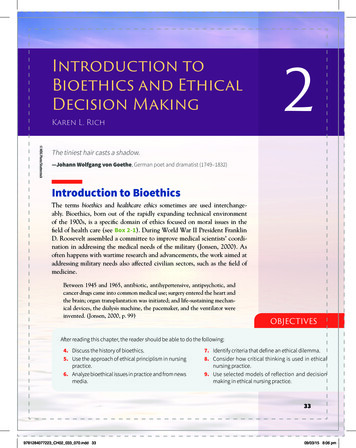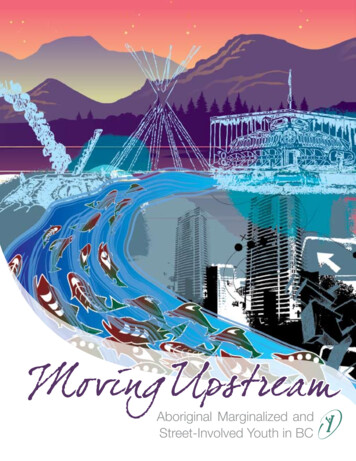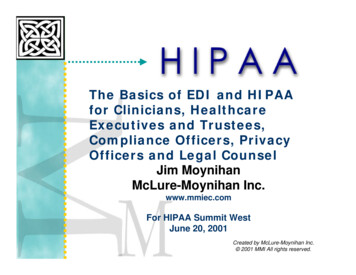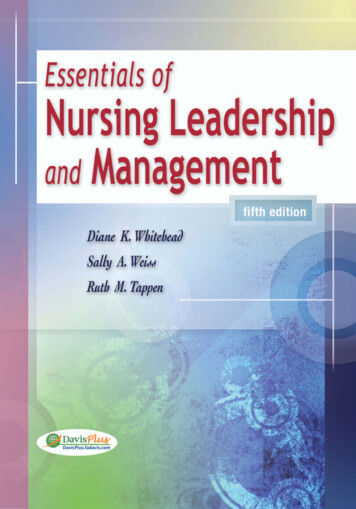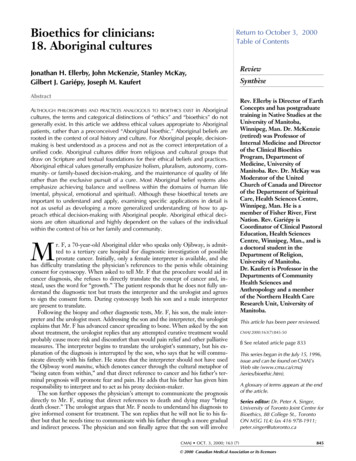
Transcription
Bioethics for clinicians:18. Aboriginal culturesReturn to October 3, 2000Table of ContentsJonathan H. Ellerby, John McKenzie, Stanley McKay,Gilbert J. Gariépy, Joseph M. KaufertAbstractALTHOUGH PHILOSOPHIES AND PRACTICES ANALOGOUS TO BIOETHICS EXIST in Aboriginalcultures, the terms and categorical distinctions of “ethics” and “bioethics” do notgenerally exist. In this article we address ethical values appropriate to Aboriginalpatients, rather than a preconceived “Aboriginal bioethic.” Aboriginal beliefs arerooted in the context of oral history and culture. For Aboriginal people, decisionmaking is best understood as a process and not as the correct interpretation of aunified code. Aboriginal cultures differ from religious and cultural groups thatdraw on Scripture and textual foundations for their ethical beliefs and practices.Aboriginal ethical values generally emphasize holism, pluralism, autonomy, community- or family-based decision-making, and the maintenance of quality of liferather than the exclusive pursuit of a cure. Most Aboriginal belief systems alsoemphasize achieving balance and wellness within the domains of human life(mental, physical, emotional and spiritual). Although these bioethical tenets areimportant to understand and apply, examining specific applications in detail isnot as useful as developing a more generalized understanding of how to approach ethical decision-making with Aboriginal people. Aboriginal ethical decisions are often situational and highly dependent on the values of the individualwithin the context of his or her family and community.Mr. F, a 70-year-old Aboriginal elder who speaks only Ojibway, is admitted to a tertiary care hospital for diagnostic investigation of possibleprostate cancer. Initially, only a female interpreter is available, and shehas difficulty translating the physician’s references to the penis while obtainingconsent for cystoscopy. When asked to tell Mr. F that the procedure would aid incancer diagnosis, she refuses to directly translate the concept of cancer and, instead, uses the word for “growth.” The patient responds that he does not fully understand the diagnostic test but trusts the interpreter and the urologist and agreesto sign the consent form. During cystoscopy both his son and a male interpreterare present to translate.Following the biopsy and other diagnostic tests, Mr. F, his son, the male interpreter and the urologist meet. Addressing the son and the interpreter, the urologistexplains that Mr. F has advanced cancer spreading to bone. When asked by the sonabout treatment, the urologist replies that any attempted curative treatment wouldprobably cause more risk and discomfort than would pain relief and other palliativemeasures. The interpreter begins to translate the urologist’s summary, but his explanation of the diagnosis is interrupted by the son, who says that he will communicate directly with his father. He states that the interpreter should not have usedthe Ojibway word manitoc, which denotes cancer through the cultural metaphor of“being eaten from within,” and that direct reference to cancer and his father’s terminal prognosis will promote fear and pain. He adds that his father has given himresponsibility to interpret and to act as his proxy decision-maker.The son further opposes the physician’s attempt to communicate the prognosisdirectly to Mr. F, stating that direct references to death and dying may “bringdeath closer.” The urologist argues that Mr. F needs to understand his diagnosis togive informed consent for treatment. The son replies that he will not lie to his father but that he needs time to communicate with his father through a more gradualand indirect process. The physician and son finally agree that the son will involveReviewSynthèseRev. Ellerby is Director of EarthConcepts and has postgraduatetraining in Native Studies at theUniversity of Manitoba,Winnipeg, Man. Dr. McKenzie(retired) was Professor ofInternal Medicine and Directorof the Clinical BioethicsProgram, Department ofMedicine, University ofManitoba. Rev. Dr. McKay wasModerator of the UnitedChurch of Canada and Directorof the Department of SpiritualCare, Health Sciences Centre,Winnipeg, Man. He is amember of Fisher River, FirstNation. Rev. Gariépy isCoordinator of Clinical PastoralEducation, Health SciencesCentre, Winnipeg, Man., and isa doctoral student in theDepartment of Religion,University of Manitoba.Dr. Kaufert is Professor in theDepartments of CommunityHealth Sciences andAnthropology and a memberof the Northern Health CareResearch Unit, University ofManitoba.This article has been peer reviewed.CMAJ 2000;163(7):845-50ß See related article page 833This series began in the July 15, 1996,issue and can be found on CMAJ’sWeb site (www.cma.ca/cmaj/series/bioethic.htm).A glossary of terms appears at the endof the article.Series editor: Dr. Peter A. Singer,University of Toronto Joint Centre forBioethics, 88 College St., TorontoON M5G 1L4; fax 416 978-1911;peter.singer@utoronto.caCMAJ OCT. 3, 2000; 163 (7) 2000 Canadian Medical Association or its licensors845
Ellerby et alother family members over the next 48 hours. The physician and family arrange to meet again in 2 days and, in themeantime, to hold a “sharing circle” (see Appendix 1 for definition) in which patient, family members and caregiverswill discuss palliative care and answer Mr. F.’s questions.provides the basis for identifying widely held values in Aboriginal frameworks for decision-making.What is Aboriginal bioethics?Some essential qualities of ethical approaches to communication and caregiving involving Aboriginal peoples aresummarized in Table 1. Although these ethical values areimportant to understand and apply, examining specific applications of ethical care in detail is not as useful as developing a more generalized understanding of how to approach ethical decision-making with Aboriginal people inactual clinical settings. Aboriginal ethical decisions are often situational and highly dependent on individual valuesand on the context of the family and community.In general, Aboriginal ethical values include the concepts of holism, pluralism, autonomy, community- or family-based decision-making, and the maintenance of qualityof life rather than the exclusive pursuit of a cure. MostAboriginal belief systems also emphasize achieving balanceand wellness within all domains of human life (mental,physical, emotional and spiritual).Aboriginal North American cultures share some ethicalpractices, such as the need to respect the integrity of thehuman body after death.1,2 Spirituality and cultural understandings of death, loss and the existence of Spirit Beingsoften play a role in the bioethical decisions of Aboriginalpatients and families.1 Acceptance is a common, deeplyrooted aspect of Aboriginal relationships to death and thepassage of time during illness.11–16 Maintaining quality of lifeAlthough philosophies and practices analogous tobioethics do exist in Aboriginal cultures, the concept of“bioethics” is not generally differentiated from the ethicalvalues and frameworks for decision-making that are applied in all dimensions of living. Accordingly, we will address ethical values that may be held by Aboriginal peoplerather than a formal, codified system of Aboriginalbioethics.A recent review of the literature revealed that little hasbeen published on the subject of Aboriginal health ethics.1In the scope of cultural bioethics, Aboriginal systems areunique in their respect for the visions and beliefs of the individual and concomitant respect for the community.2 Aboriginal values are frequently discounted by Western colonial culture. Primarily rooted in the context of oral historyand culture, Aboriginal ethics are best understood as aprocess and not as the correct interpretation of a unifiedcode.1,3 In their approach to ethical decision-making, Aboriginal cultures differ from religious and cultural groupsthat draw on Scripture and textual foundations for theirethical beliefs and practices. Despite these challenges, common themes and the diversity within Aboriginal ethics maybe highlighted. Research conducted with Aboriginal elders4Themes in approaches to communicationand caregivingTable 1: Essential qualities of ethical approaches to communication and caregiving involving Aboriginal peopleRespect the individual: Individual experience and beliefs are viewedto be as valid and important as tradition or cultural norms.1 Althoughclosely bound to family and community in identity, individuals arerecognized has having authority over their own health and “healingjourney.” When communicating with an Aboriginal person, it isimportant to show respect, especially for the aged and those withhigh status such as elders.Practise conscious communication: Try to listen well and noteresponses, not only in speech but also, if possible, in body language.Emotional control is common among Aboriginal people and it may bedifficult for non-Aboriginal people to “read” intonation and bodylanguage.Use interpreters: Use an interpreter if there is any doubt as to fluencyand understanding in English or French. Interpreters often assist inexplaining and advocating for the patient.5Involve the family: Often Aboriginal families will wish to be presentduring decision-making. Family members can be helpful inunderstanding the patient's beliefs and wishes. Patients may notstrongly differentiate their own best interest from that of their family.Because of the individuality of values, however, family members maynot always be suitable as interpreters. “Immediate family” caninclude many extended relations and may be very large and thusshould be affirmed.6*See Appendix 1 for definitions of sharing circles and smudging.846JAMC 3 OCT. 2000; 163 (7)Recognize alternative approaches to truth-telling: Aboriginal peoplemay believe that speaking of a future illnesses or consequence willbring it to pass. Family members may not wish “bad news” to becommunicated directly.7,8 Freedman's notion of “offering truth” may behelpful.9 Mystery is an acceptable frame of reference for manyAboriginal people, and uncertainty in prognosis or disease progressionis often easily accepted by Aboriginal people in contrast to nonAboriginal people. Beneficence must be weighed carefully against theexpressed wishes of Aboriginal patients and their families.Practise noninterference: A patient’s decisions should be based on acomprehensive reporting of options and be respected except forreasons of misunderstanding. Some decisions will be based on culturalknowledge or personal identity, and it will not be possible to reconcilethese with medical knowledge. Also, many Aboriginal people acceptmedical advice without question as a sign of trust and respect forpeople in the role of “healer.” It is important not to abuse this nonchallenging trust when presented. Rational persuasion may beexperienced as coercion by Aboriginal people.10Allow for Aboriginal medicine: Aboriginal patients may desire theinvolvement of Aboriginal elders, healers, medicine people or priests intheir treatment. These practitioners are understood to be vital to theoverall integrated health of a person and should be respected andhonoured whenever possible. Sharing circles, smudging (using herbalbased incense) and traditional herbal remedies may be aspects ofcultural medical treatments.*
Bioethics and Aboriginal peoplesis commonly seen as paramount to extending life. Simultaneously, life is to be preserved and should be pursuedwhenever meaningful quality can be maintained. Affirmingthe dignity of life is essential.10Some Aboriginal people have a problem with advancedtechnology, and it is important to acknowledge this in treatment. Problems arise when a cultural heritage of naturebased medicine encounters biomedical treatment emphasizing technological interventions. Health care institutionssuch as urban teaching hospitals may be associated with a“culture of colonization” emphasizing technological solutions. There are diverse perspectives in Aboriginal communities regarding the use of technologically advanced and aggressive treatments such as transplantation, dialysis andmechanical ventilation. However, many Aboriginal people,particularly the young, may be open to and desirous of usingthe full range of medical technologies available.BarriersEthical care of Aboriginal peoples may include the current emphasis in bioethics on the moral context of individual relationships in clinical interactions. However, this approach does not fully engage the broader structural contextof barriers that impede access to care or interfere with healing processes. Barriers include language problems, lack ofcultural competence among health care providers, problemsof transportation and communication in service delivery toremote communities, and institutional discrimination.Applications of the bioethical principles of autonomy,beneficence and justice in contemporary relationships mustrecognize the historical context of power relationships between Aboriginal people and providers of health and socialservices. The dominant emphasis on respect for individualautonomy in bioethics may need to incorporate Aboriginalvalues emphasizing noninterference. The Aboriginal psychiatrist, Clare Brant,10 observed:The ethic of non-interference is a behavioural norm of NorthAmerica Native tribes that promotes positive interpersonal relations by discouraging coercion of any kind, be it physical, verbalor psychological.Approaches to guaranteeing autonomy in communication involving consent and truth-telling must accommodatethis value of avoiding coercion. Direct, unmediated communication of “bad news” involving terminal prognosis orrisks of impending death may violate some individual’s andcommunity’s values. Cultural and spiritual traditions, including those of Navajo people in the United States andDene people in Canada, assert that speaking explicitlyabout terminal illness and death may hasten
(retired) was Professor of Internal Medicine and Director of the Clinical Bioethics Program, Department of Medicine, University of Manitoba. Rev. Dr. McKay was Moderator of the United Church of Canada and Director of the Department of Spiritual Care, Health Sciences Centre, Winnipeg, Man. He is a member of Fisher River, First Nation. Rev. Gariépy is
